The Web as a Material
Material 2017 conference on August 17th, Reykjavík, Iceland
When Brian and I had the idea of running an event in Rekyjavík about 3 years ago and when we finally decided on a topic in late 2015 — to look at the Web as a Material and explore it from a variety of angles — we were not really knowing where this would lead us. Now that I'm sitting on the train back home, returning from a wonderful first Material Conference 2017 with a ton of impressions of a wonderful day, I can tell you that taking this challenge was not a mistake.
24 years ago, right after I finished secondary school and before I started studying interior design, I spent a full year at the Werkbund Werkstatt Nürnberg. The concept of this school was quite unique at that time, and I think it still is. The curriculum consisted of working with various materials like wood, metal, glass, paper, fabrics and so on, and we also had some basic design lessons.
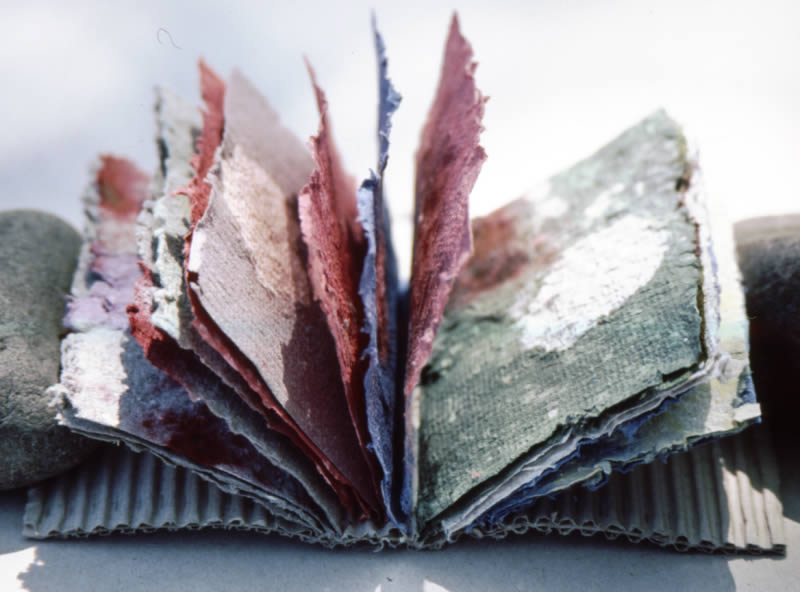
Paper experiments in the Werkbund Werkstatt Nürnberg
What we did during that year was neither art, nor were we learning a particular craft. The goal was rather to gain experience with the materials and get a deep understanding of their characteristics, affordances and of the right tools to work on them. Believe me or not, but in the beginning we had students that were totally convinced that a hammer would be the perfect tool for treating a raw log of wood. The reason for this misconception was that our traditional school system more and more failed (and still fails) to teach us the basic knowledge about the physical things around us — knowledge, that our parents and grandparents certainly still had. This is exactly the gap the school wanted to close.
Later on I began working for the WWN, and still today my colleagues and I are in charge of their website. My year there had a huge impact on my career and way of thinking, to say the least.
Around 2 years after my time at the WWN I launched my first website, so I was also dealing with digital stuff at the same time. Some of you will remember that working on the Web was a lot of trial and error back then, but actually it was quite easy: You just needed a text editor and some HTML knowledge and you could just hack right away. I had the chance to grow with the Web and learn its tools and languages from the ground up.
The Web vs. traditional materials
When I look at the modern generation of web developers and designers, however, it seems to me that in the meantime the Web has changed to suffer from the same problems as traditional materials do. Many entrants start their career by randomly throwing frameworks and boilerplates on the Web without really understanding what's going on behind the scenes. They're mostly overdoing it and spending more time on fixing the damage they cause themselves instead of learning their craft from bottom to top. I get that this is probably a side effect of the extremly fast pace the web is having.
Compared to traditional materials, there are several major observations to make:
- The Web has (almost) no history (yet). In its short life, it has already outlived itself several times. Things that were state of the art at some point are already long forgotten again. Think of the recent announcement of the EOL of Flash: In only a couple of years it will be impossible to even redisplay millions of once great innovations. In contrast, traditional crafts and materials have evolved over centuries or millennia instead of years or decades — far more time to let discoveries sink.
- Probably as a result of the Web's fast pace and the shortness of its history, there's no proper documentation of the way it came along for future generations. While traditional materials can easily fill their own museums, covering ages of innovation and experience, I'm not aware of anything comparable for the Web. Well, there's the Internet Archive, you could say. But while this does a good job at preserving certain states of the Web, it's not really able to depict the evolution of the Web in a way you could easily learn from (not to mention that it can't solve the problem of disappearing technologies — in the future, there will be no way to re-experience Flash websites even if they got archived in the past).
- The concepts of apprenticeship and mastership seem to not apply on the Web. When it comes to building a house, you will search for a trusted architect and carpenter, and you'll measure their credibility by means of their experience, which in turn will be a matter of the time they spent exercising their craft. On the Web, even the 16-year-old nephew of your neighbour seems to be able of doing the job. Developers tend to call themselves "engineers" without being aware of the public responsibility that this title used to come along with.
With the modern generation of web developers in mind, I always wondered if it would be helpful to take a sideways look to the traditional materials and see how they evolved over time. Maybe there's something we can learn for the Web?
Material conference: A first attempt
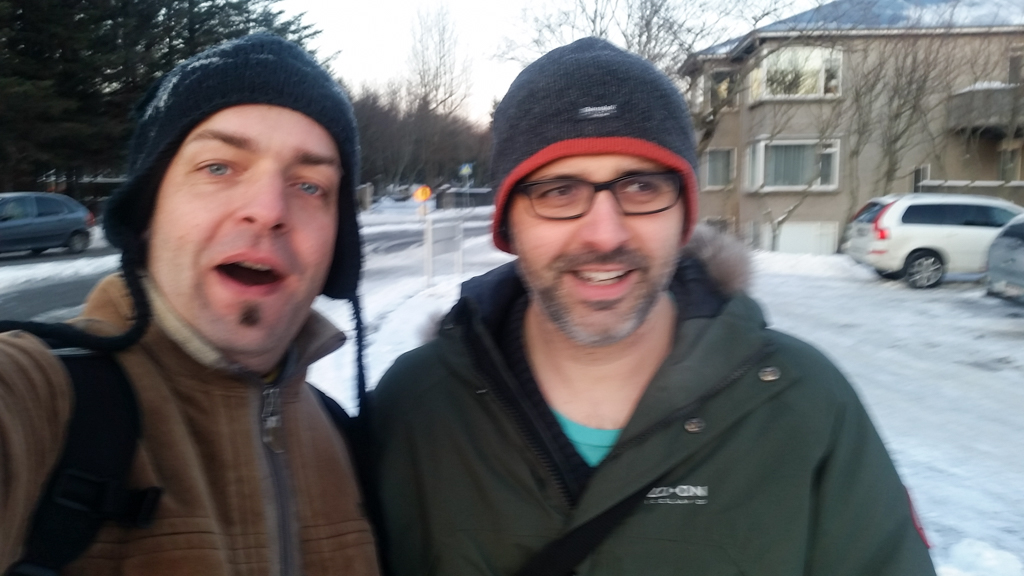
Brian and I in Reyjkavík, January 2016
I met Brian for the first time at the IndieWebCamp in Brighton in September 2014. I knew he lived in Iceland (where I had spent some time 15-20 years ago), so we had some things to chat about. When we met again at beyond tellerrand // BERLIN 2014 a couple of months later, I had just run the border:none 2014 conference and was admittedly in a very frustrated state. Nevertheless, when Brian asked me if I'd be interested in teaming up and running an event in Reykjavík together, I didn't even think a second. Of course I was!
I introduced Brian to my thoughts about the Web and materials and he immediately resonated with the idea of making this the topic of our event. We reflected on our ideas for a couple of months, set out to make a first attempt and finally scheduled a Material conference for July 22nd, 2016. We decided to run a Kickstarter for the event.
Long story short: We couldn't find enough backers in time and the Kickstarter failed, so no Material conference happened in 2016. We had taken the risk of failing into account though and thus were not too disappointed. Instead, we promised to be back in 2017 with another attempt and took some time to digest our learnings:
- Iceland is a tough place for running an event like ours, which is mostly due to the high prices for travelling and staying there. While we tried to keep the costs for the conference as low as possible, a lot of people simply couldn't afford getting there. Of course the date we picked had a big impact as well: July is high season in Iceland, so not only prices are particularly high around that time but also potential sponspors weren't too interested in supporting us. They're more keen on getting people to Iceland during the low season.
- Our topic is far to "meta" to easily convince bosses to send their employees to our conference. Had we picked e.g. JavaScript as the topic, our chances to attract more international audience would've been better.
- On the other hand, Icelanders tend to not commit to a date until say a week before. That's probably just their mentality. While the results of a little survey Marc and I ran some time before showed that most people prefer to plan their conference attendances about 4 months ahead, this doesn't seem to apply for Icelanders. Of the ~50 backers of our Kickstarter campaign only 1 or 2 were from Iceland. Planning an event in advance with a reliable Icelandic attendance rate seems just impossible. This of course runs completely counter to how Kickstarter works.
- Finally, Kickstarter itself turned out to be an inappropriate tool for promoting our event. Due to the significant financial effort people would've had to put into attending the conference, many wanted to construct a little holiday around the date and maybe even bring their families. As the outcome of the campaign was open, though, no one really dared asking their employer for leave days — which in turn made them refrain from backing us on Kickstarter. Also, almost 100% of our backers were out of Brian's or my immediate network and we apparently didn't benefit at all from Kickstarter's social platform aspects (which, of course, was also because our campaign wasn't popular enough to rank high).
Material conference reloaded

Amber and Steffen strolling around the Nordic House on the day of the conference
Last week, on August 17th, 2017, the first Material conference finally became a reality.
Compared to the previous year we had tweaked our setup in some major points. First, we ditched Kickstarter and took the risk of failing upon ourselves so that people could reliably plan their trip without having to worry whether the conference would take place or not. And apparently, some did succeed in creating a nice little holiday around the event.
Double Rainbow. Because, why not. Iceland rocks. (https://t.co/MJrRbHcGv4) pic.twitter.com/FWWXwtWRLa
— Steffen Rademacker (@webgefrickel) 16. August 2017
We tried even harder to keep the ticket price low and saved costs wherever we could. I honestly don't know yet if we broke even, but if we did, all speakers will benefit as we ran this as a co-op between us and them. We didn't spend any money on promotional stuff or swag. And we didn't have any sponsors (except ourselves).
The venue
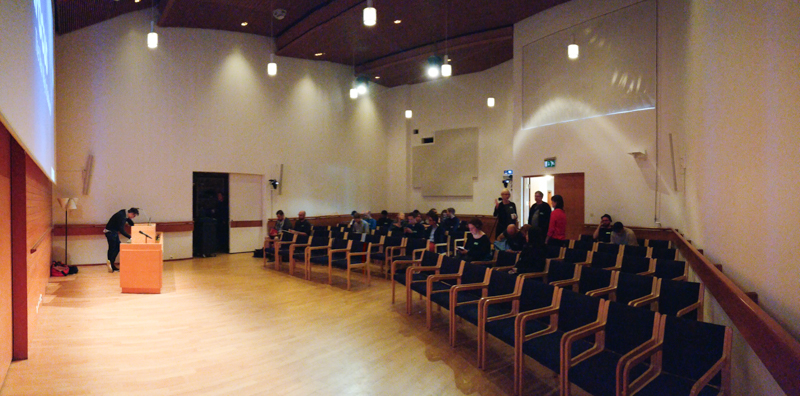
The technically well equipped hall in den Nordic House, Reykjavík
We reduced the number of attendees to 60 and tailored everything to this new goal, which also implied finding a smaller venue. Brian came up with the Nordic House, which turned out to be a genius idea. Not only do I really like this historic building by Finnish architect Alvar Aalto — he had been subject of my studies which was the reason why I had already visited the building in the 90s —, it's also a great example for the mastery of various materials as Aalto meticulously designed everything from the architecture over the furniture to the door handles. The size of the hall perfectly suited our needs and the fact that the building also houses a restaurant allowed us to have a delicious lunch together with all the attendees and speakers. In addition, the building is well equipped with recording technology so that we were able to live-stream the talks and will publish videos once the editing is done.
The speakers

Amber, Brian, Tommy, Dan, Goddur, Hannah & Justin having fun at the speakers dinner
We were lucky enough to find an exceptional line-up of speakers, both from Iceland and from abroad (in the order of their talks):
- Hannah & Justin Floyd from Solidwool, talking about new ways of working with wool
- Michal Ryan from Omnom Chocolate, giving us a mini-bean school and insights into their production process
- Amber Wilson, telling us about the differences and similarities of psychology and the Web
- Halldór Eldjárn with the sounds of ~15,000 NASA photos (and other projects)
- Goddur — artist, graphic designer and Iceland's by far best-known commentator on design issues
- Tristan Ferne, introducing us to BBC R&D's approach towards stories and the Web
- Tristan Gribbin with her latest project combining meditation and VR
- Dan Rubin, giving a quasi-spontaneous mini-talk and connecting the dots between all prior speeches
- Polaroid Swing's co-founder Tommy Stadlen with his vision of the future of photographs and some top-secret product news
The event
Well, where should I start? As an organiser, I'm probably uncapable of feeling the same atmosphere as other attendees and speakers do — Jeremy and Amber already did a great job on depicting their perception and I'll leave it up to them to give you an impression of what you missed.
I know it’s a cliché to talk about a conference as being inspirational, but I found myself genuinely inspired by what I heard today. I don’t mean inspired in the self-help feel-good kind of way; I mean the talks inspired thoughts, ideas, and questions.
[…]
If this event happens again next year, I’ll be back.
Jeremy Keith
As far as I'm concerned, the day absolutely exceeded my expectations. One of my biggest concerns has always been the question whether people would see the relevance of traditional materials for our profession as webworkers. Whether they'd be able to derive something valuable for their personal context. The topic could have easily gotten out of control and people could have left the conference with head-shaking and shoulder-shrugging. But in reality, the opposite was the case — which makes me very, very happy:
If you missed the conference for some reason, Justus Sturkenboom's sketchnotes might give you a glimpse of what the talks were about:
Brian's brilliant narrative throughout the day played an important role in glueing all the various aspects together — he did a fantastic job on that! I wish I were that smart and eloquent as well.
Personal highlights
The event went extremely smooth, nothing unexpected happened and Brian and I were able to keep pretty relaxed throughout the day. While everything was enjoyable, I'd like to point out some personal highlights that really touched my heart in some way.
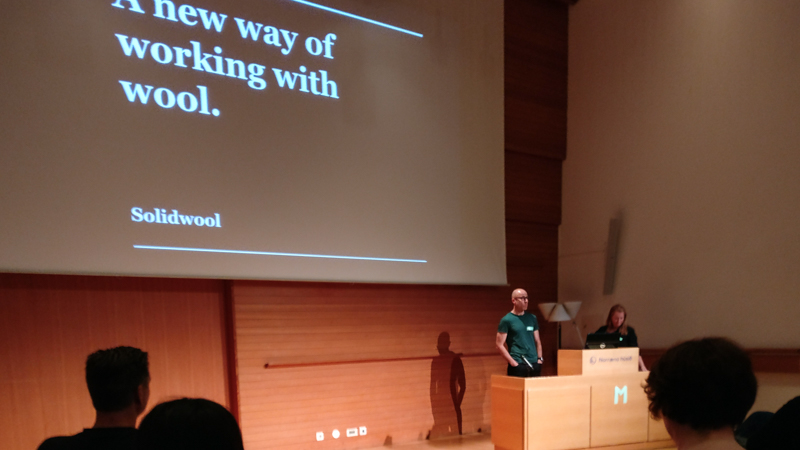
Hannah & Justin Floyd telling the story of Solidwool
First, there's the opening talk of Hannah and Justin Floyd, who told us their story of how they invented and evolved Solidwool, a material similar to glass fibre but made out of sheep wool. They use it to produce furniture and other accessories. Their talk was the most untechy one and you might have expected it to be somewhat unrelated, but for me personally it was the most moving one — I cannot imagine a better kickoff into the day. During their talk, it became clear that there's so much more behind their story than just the development of a new material out of a waste product. They're working with the local farmers and try to bring fairness into the monopolistic wool market, at least at a local level. They take responsibility and try to improve the social fabric with their inventions — something that's more than relevant for the Web as well. I was truly impressed by their motivation and story!
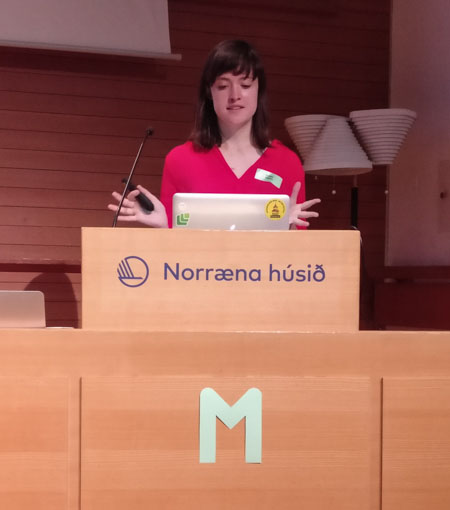
Amber giving her first ever conference talk about Psychology and the Web
My next highlight was of course Amber's talk about "Psychology and the Web". Only few people knew that this was her first ever talk in front of a conference audience — and if you knew, it was hard to believe. I know she worked tirelessly on improving her skills ever since I offered her a speaking slot in late March — and oh boy, how did she deliver! I'm really feeling proud for her and am very much looking forward to seeing her on stage again at the Nightlybuild 2017 conference in two weeks.
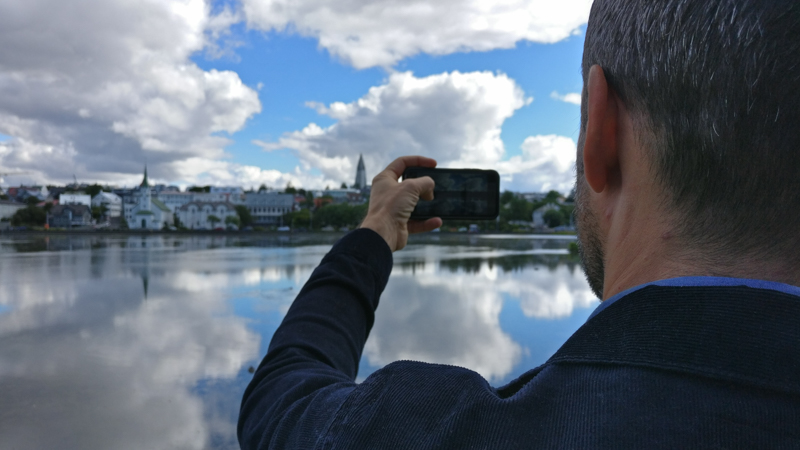
Dan Rubin taking a picture of Tjörnin, Reykjavík's city lake
Last but not least I'd like to emphasise what great pleasure it was to have Dan's support on so many levels. Not only did he introduce us to several of the speakers, he also helped us promote the conference, took videos and photos throughout the day and even agreed to give a short mini-talk when we asked him only one day before the conference. In his quasi-spontaneous slot he brilliantly merged all the previous speakers' messages into a single, conclusive thread, masterfully leading over to Tommy's closing talk. It was epic, Dan — thanks so much!
An outlook
Even though we're still decompressing and need more time for drawing profound conclusions, I think it's ok to call the conference a success. We already have a couple of ideas for the next iteration. One of them could be teaming up with the JSConf Iceland and running our next event very close to that — which would be no later than early March, 2018. I think we'll decide on this very soon, so stay tuned!
Furthermore, those of you who know my affiliation to the Nürnberg Web Week won't be suprised that I'm thinking even further out of the box. Last week we met with Ægir, one of the JSConf organisers, and some of his friends to discuss the idea of starting something like a "Reykjavík Web Week" around our two conferences. Of course I cannot play a major part due to my geographical distance but at least I can give an impetus and contribute the experience I made in more than 4 years of NUEWW. To be honest, I'm very excited about this idea and will definitely keep you updated.
Thank you!
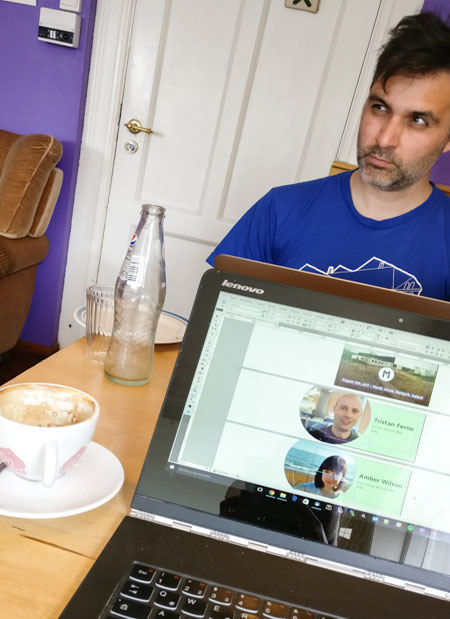
Brian working on his narrative for the conference
I'd like to close this with a big round of "thank yous". Thank you, dear attendees, that you put your trust in us and made the effort to join the conference without really knowing what was expecting you! Thank you, dear speakers, that you made this event possible by contributing your unique stories and perspectives — you made it all worth it! Thank you, invisible helpers behind the scenes, for making everything running so smoothly!
And finally: Thank you, Brian — you made it an extraordinary event I would never have been able to run without you. Let's do this again!

Brian and Joschi in front of the Nordic House, Reykjavík, on the morning of Material 2017 (Photo by Dan Rubin)
There's a selection of photos of the conference (and the days before) available on Flickr. Thanks to Dan Rubin for his great shots!